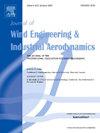LES study on inversion-capped atmospheric boundary layer flows over steep topography considering the effects of free-atmosphere lapse rate
IF 4.9
2区 工程技术
Q1 ENGINEERING, CIVIL
Journal of Wind Engineering and Industrial Aerodynamics
Pub Date : 2025-07-03
DOI:10.1016/j.jweia.2025.106131
引用次数: 0
Abstract
The capping temperature inversion is a common atmospheric phenomenon that strongly influences the mean flow and turbulence structures within the atmospheric boundary layer (ABL). In this study, full-scale large eddy simulations are utilized to shed light on the characteristics of inversion-capped ABL flows over steep hilly terrain. As atmospheric stratification increases, the vertical wind veer becomes stronger, creating asymmetric flow patterns in the hill wake, and the buoyancy force acts to resist turbulent wake motions. In contrast to the conventionally neutral boundary layer (CNBL) and the convective boundary layer (CBL) cases, the stable boundary layer (SBL) exhibits pronounced flow acceleration at the hilltop and a faster wake recovery on the lee side of the hill. Based on the quadrant analysis, flow separation and vortex shedding are found to enhance organized motions downstream of the hill crest. In the wake region, sweep and ejection motions are identified at different heights. Furthermore, a wind speed prediction approach is developed for inversion-capped ABL flows over steep hilly terrain under both stable and unstable stratifications. The proposed approach incorporates the effect of the free-atmosphere lapse rate. Overall, it shows satisfactory agreement in predicting mean wind speed profiles over steep hills under both CBL and SBL conditions. The overestimation of mean wind speed at the hilltop in the SBL case can be corrected using the coordinate transformation technique.
考虑自由大气递减率影响的陡地形上逆温封顶大气边界层流动的LES研究
封顶逆温是一种常见的大气现象,对大气边界层内的平均气流和湍流结构有很大的影响。在这项研究中,利用全尺寸大涡模拟来揭示逆温封顶的ABL流在陡峭丘陵地形上的特征。随着大气分层的增加,垂直风转向变得更强,在山丘尾流中形成不对称的流动模式,浮力起着抵抗湍流尾流运动的作用。与传统的中性边界层(CNBL)和对流边界层(CBL)情况相比,稳定边界层(SBL)在山顶表现出明显的流动加速,在背风面表现出更快的尾迹恢复。基于象限分析,发现流动分离和旋涡脱落增强了坡顶下游的有组织运动。在尾迹区,不同高度的掠射运动被识别出来。在此基础上,建立了稳定和不稳定分层条件下,逆温封顶ABL气流在陡峭丘陵地形上的风速预测方法。该方法考虑了自由大气递减率的影响。总体而言,在CBL和SBL条件下,对陡坡平均风速廓线的预测结果具有满意的一致性。利用σ坐标变换技术,可以对SBL情况下山顶平均风速的过高估计进行修正。
本文章由计算机程序翻译,如有差异,请以英文原文为准。
求助全文
约1分钟内获得全文
求助全文
来源期刊
CiteScore
8.90
自引率
22.90%
发文量
306
审稿时长
4.4 months
期刊介绍:
The objective of the journal is to provide a means for the publication and interchange of information, on an international basis, on all those aspects of wind engineering that are included in the activities of the International Association for Wind Engineering http://www.iawe.org/. These are: social and economic impact of wind effects; wind characteristics and structure, local wind environments, wind loads and structural response, diffusion, pollutant dispersion and matter transport, wind effects on building heat loss and ventilation, wind effects on transport systems, aerodynamic aspects of wind energy generation, and codification of wind effects.
Papers on these subjects describing full-scale measurements, wind-tunnel simulation studies, computational or theoretical methods are published, as well as papers dealing with the development of techniques and apparatus for wind engineering experiments.

 求助内容:
求助内容: 应助结果提醒方式:
应助结果提醒方式:


